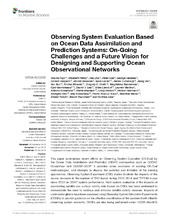| dc.Published | Fujii Y, Rémy, Hao, Oke, Halliwell, Gasparin F, Benkiran M, Loose N, Cummings, Xie NERSC, Xue Y, Masuda, Smith, Balmaseda M, Germineaud, Lea, Larnicol G, Bertino L, Bonaduce A, Brasseur P, Donion, Heimbach P, Kim, Kourafalou, Le Traon P, Martin, Paturi, Tranchant B, Usui. Observing system evaluation based on ocean data assimilation and prediction systems: On-going challenges and future vision for designing/supporting ocean observational networks. Frontiers in Marine Science. 2019;6:417 | eng |
| dc.description.abstract | This paper summarizes recent efforts on Observing System Evaluation (OS-Eval) by the Ocean Data Assimilation and Prediction (ODAP) communities such as GODAE OceanView and CLIVAR-GSOP. It provides some examples of existing OS-Eval methodologies, and attempts to discuss the potential and limitation of the existing approaches. Observing System Experiment (OSE) studies illustrate the impacts of the severe decrease in the number of TAO buoys during 2012–2014 and TRITON buoys since 2013 on ODAP system performance. Multi-system evaluation of the impacts of assimilating satellite sea surface salinity data based on OSEs has been performed to demonstrate the need to continue and enhance satellite salinity missions. Impacts of underwater gliders have been assessed using Observing System Simulation Experiments (OSSEs) to provide guidance on the effective coordination of the western North Atlantic observing system elements. OSSEs are also being performed under H2020 AtlantOS project with the goal to enhance and optimize the Atlantic in-situ networks. Potential of future satellite missions of wide-swath altimetry and surface ocean currents monitoring is explored through OSSEs and evaluation of Degrees of Freedom for Signal (DFS). Forecast Sensitivity Observation Impacts (FSOI) are routinely evaluated for monitoring the ocean observation impacts in the US Navy's ODAP system. Perspectives on the extension of OS-Eval to coastal regions, the deep ocean, polar regions, coupled data assimilation, and biogeochemical applications are also presented. Based on the examples above, we identify the limitations of OS-Eval, indicating that the most significant limitation is reduction of robustness and reliability of the results due to their system-dependency. The difficulty of performing evaluation in near real time is also critical. A strategy to mitigate the limitation and to strengthen the impact of evaluations is discussed. In particular, we emphasize the importance of collaboration within the ODAP community for multi-system evaluation and of communication with ocean observational communities on the design of OS-Eval, required resources, and effective distribution of the results. Finally, we recommend further developing OS-Eval activities at international level with the support of the international ODAP (e.g., OceanPredict and CLIVAR-GSOP) and observational communities. | en_US |

